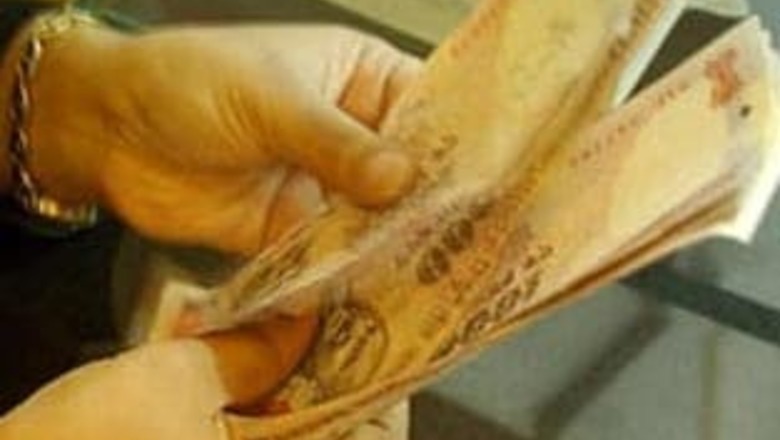
views
Imagine diving headfirst from a high springboard only to realise halfway that water has leaked out of the pool. The managers of India’s mutual funds find themselves in a similar situation today. They can hardly complain about it, because they had been forewarned of the risk.
The empty pool in the mutual fund industry goes by the name of Fixed Maturity Plan (FMP), a close-ended debt investment plan that the industry used to pad itself up, but which eventually brought it down to its knees. Now it emerges that all the steroid pumping by asset managers was pushing them closer to the edge.
“It was plain for all to see that we were playing a very dangerous game,” says the chief executive officer of a mutual fund, recalling the unrestrained growth of FMPs over the past four years when funds continually pushed the boundaries of risk and competed with each other to be the larger fund house.
As the economy boomed, money started to flow to debt and equity markets as companies. High net worth individuals sought out instruments to park their surging profits and surplus cash. Making money in the market appeared almost natural and mutual funds were in the middle of the game. While the high rollers were in the equity markets attracting most of the media attention, FMPs -- a little known system then -- wormed their way into the heart of the mutual fund industry.
By nature of the product, FMP fund managers should match the tenure of money coming in and the money being invested, so that the scheme can be closed out in the end. But as more and more money started flowing in, managers devised a way to increase their profits by investing short-term money in long-term securities. For instance, a fund would invest a chunk of the money collected for three months in securities that would mature only three years later. Such a ploy creates an asset-liability mismatch which is low-risk in times of easy money, but extremely risky during tight money conditions. The mismatch did not matter as long as the funds were able to float new FMPs when old ones matured and repay previous investors with the new money while transferring the securities in those funds to the new ones.
They were playing for high stakes, blindfolded. As early as April this year, a full six months before Lehman Brothers went bust, the Association of Mutual Funds in India (AMFI) held a general body meeting where a couple of fund managers raised the red flag on the emerging asset-liability mismatches in short-term debt funds. But with the market coming off a bull run that had lasted an astounding four years, the doves were shouted down.
The doubting fund managers pointed out that the Reserve Bank of India was pushing up interest rates by tightening systemic liquidity which might lead debt plans, especially those with a fixed investment period, into trouble. They were countered by the hawks who spouted theories on risk and reward. “The only way to make money is to take that risk,’’ one fund manager said at the meeting.
An assumption gone wrong
It was the abundance of cash that fueled the popularity of FMPs. They offer better returns than bank fixed deposits and come with tax advantage too. While returns from fixed deposits attract income tax of over 33 per cent, the peak rate at which FMP returns are taxed is at least a third lower. At their peak, these debt plans accounted for about 30 percent of mutual fund assets in the country.
Managers assumed that since they imposed a penalty of 0.25-2 per cent on premature withdrawals, no investor would pull out before maturity of the fund. But then Wall Street got a sneezing fit and the flu spread worldwide, even to ‘insulated’ India. The panic was so intense that even seemingly wise investors scampered like cats stranded on a hot tin roof.
“Some of our investors whom we serviced for a decade and with whom we are completely transparent and disclosed our portfolios totally acted foolishly. One would not expect such an irrational decision from a non-retail investor,” a fund manager told mutual fund monitoring firm Value Research in a recent interview.
Meanwhile, red ink was spreading on the asset side of the balance sheet too. Many funds had lent large sums to property developers in the hope of earning high returns as they were borrowing money at exorbitant interest rates. The exact amount that funds lent to the real estate sector is not available, but industry experts estimate it at somewhere between Rs. 7,000 crore and Rs. 10,000 crore.
The liquidity crunch had first hit developers, who had already borrowed heavily to fund scores of new projects announced in times when cheap home loans and commercial expansion had fuelled an unbridled building boom. As interest rates rose, sales began to fall and finally the bubble burst. In the last week of June, mutual funds got a preview of things to come. Three large property developers could not repay loans when they fail due on June 30.
They said they needed more time to arrange the money. A deal was made for the funds to refinance the companies at higher interest rates to repay the old loan, a practice called ever-greening. In later months many funds were to go down the same path to protect their assets from becoming duds.
Nothing much changed in the next few weeks, though money became scarcer as the last month of the second quarter of financial year approached. As happens every year, companies began to withdraw their investments in liquid funds in September to make advance tax payments. Then, on the 15th, Lehman Brothers filed for bankruptcy, sending shock waves through the global financial system. Markets crashed worldwide and banks stopped lending.
Most state-owned banks stopped disbursing even sanctioned loans. Call rates began to rule well above 10 per cent and borrowers were crowding at the RBI’s short-term lending window. It was lending anywhere between Rs. 60,000 crore and Rs. 75,000 crore each day, compared to the usual couple of thousands. The financial system virtually had a seizure as credit lines were blocked completely. Those who had borrowed against shares were frantically looking for money to save their holdings as stocks fell to new depths.
The credit squeeze forced mass withdrawals from mutual funds’ liquid schemes and short-term funds as needy companies and businesses scrambled to raise finances to keep their outfits running. Investors withdrew about Rs. 46,000 crore from short-term debt funds in September. The bank accounts of debt funds were practically empty as new investors stayed away.
There was also no way that funds could raise money selling the securities they held. “The underlying debt market is illiquid. That is a fundamental flaw in the fixed income market,” says Dhirendra Kumar, chief executive of Value Research.
Financial markets took another beating when rumours about trouble brewing in ICICI Bank – the country’s largest private lender – started doing the rounds. Investor confidence was badly mauled and the central bank had to issue a statement on September 30 reassuring depositors and markets about the soundness of the bank.
At an AMFI meeting the previous day, many fund managers had called for FMPs to be shut down. There was a show of hands where nearly half the members present voted in favour. The meeting ended inconclusively. By then many real estate developers had let funds know that they would not be able to meet the repayment schedule of September 30 as well. The debt positions were rolled over again.
Emergency response
On October 1, the high level committee on capital markets that includes Securities and Exchange Board of India (SEBI), Reserve Bank of India (RBI) and Insurance Regulatory Development Authority (IRDA) met to take stock of the situation. SEBI asked for liquidity support for mutual funds but the central bank remained non-committal, merely saying that it would look into the matter.
The rumours about ICICI Bank continued to spread in the market and foreign and local investors hammered down the stock. In the second week of October, according to sources, the RBI informally asked ICICI to meet its liquidity requirements without using the central bank liquidity window. On October 8, the bank withdrew a little over Rs 2,000 crore of its investments in mutual funds. The same day, portfolio investors are also believed to have withdrawn some large deposits kept with the bank for repatriation. The bank also borrowed heavily from other banks in the call money market to meet its requirements.
As the crunch began to hurt, the finance ministry and the central bank headed to the war room. The RBI finally cut the cash reserve ratio on October 10, pumping in Rs 20,000 crore into the system. Four days later, it slashed the cash reserve ratio by another percentage point even as the RBI governor reassured the public that the Indian financial system was safe. However, money was still not reaching mutual funds as investors continued to withdraw from debt funds and lending sources were nowhere to be found.
The industry went into a tizzy. Fund managers consulted one another and AMFI. On October 13, a delegation led by the association chief A.P. Kurian met SEBI officials. Kurian was accompanied by Milind Barve, managing director, HDFC Mutual Fund, A Balasubramaniam, chief investment officer, Birla Sun Life and Sandesh Kirkire, CEO, Kotak Mahindra Mutual Fund. They gave a blunt message to SEBI – debt funds were teetering on the brink. If the fund houses suffered, their sponsors -- some of them non-banking finance companies and also big borrowers from mutual funds -- would also suffer.
When the industry representatives met RBI, they did get a patient hearing from the regulator. The funds pointed out that their sector had to face redemption within a day or two. “If there was no liquidity and the ability to sell assets (was) also constrained, redemptions cannot be met,” said an industry representative.
The mutual fund industry itself had parked around rupees two lakh crores with banks as deposits and with this fact they could impress on the Central bank it was only legitimate that they be given a special facility. The backdrop against which they were asking for special support helped them. Banks, the only possible lenders, were themselves borrowing Rs. 75,000 crore from RBI.
“How will you repay, who will you repay, who will take the credit risk and what is the size of fund requirements,” were the questions RBI asked. AMCs wanted money against the certificates of deposits they were holding and RBI didn’t see any problems of guarantee on the money lent.
Next morning, the central bank lifted the ban on bank lending to mutual funds against certificates of deposit. A day later, it threw a lifeline to the industry by instituting a special lending window for up to Rs. 20,000 crore. AMFI quickly pushed the Indian Banks Association to send a message to the industry that banks were willing to lend. IBA called a press conference with two PSU bank chairmen assuring that they would lend money to AMCs. But, another surprise was in store for the funds.
Banks, faced with tight liquidity conditions themselves, wanted high return for their money. “They were asking for 20-24 per cent interest rates. There was no way we could borrow at those rates,’’ said one fund manager. It didn’t help that funds had lured away bulk depositors from banks with the promise of higher returns in FMPs.
The noose tightens
For some, it was the end of the road. News began to circulate that Lotus Mutual Fund was up for sale. Lotus had been badly hit by redemptions and it required about Rs. 500 crore to tide over the crisis. Its sponsors, Temasek Holdings and Sabre Capital, were unwilling to bail it out. Finally Delhi-based Religare Aegon came in for rescue. It first pumped in money to bail out the fund before announcing the takeover. Another large fund was bailed out by its parent, a large non-banking finance company, by buying a part of its portfolio for about Rs 600 crore. The bailout is believed to have cost the finance company heavily as it was in the market a few days later borrowing money from two state-owned banks at an annualised interest rate of nearly 20 per cent.
As the worst appeared to pass, the regulator called the mutual fund association for a meeting on November 17. SEBI Chairman C B Bhave gave industry representatives a week to come up with suggestions to bolster the industry’s structure and improve prudential measures. Whatever happens, “investors should not suffer”, Bhave is said to have told them.
AMFI immediately formed a panel headed by Nilesh Shah of ICICI Prudential and within four days, came up with a set of recommendations. On its part, SEBI moved to ban premature withdrawals in close-ended funds and mandated that schemes invest in paper with a similar tenure as their own. All close-ended schemes will have to be listed on stock exchanges so that funds don’t take the brunt of redemption pressures. Now the industry could breathe easy.
The crisis will doubtless leave a lasting imprint on the mutual fund industry. Measures will have to be put in place to ensure that they don’t take such risks with people’s money. What Gordon Gecko in the movie Wall Street said was wrong. Greed is not good.
Like this article? Download it



















Comments
0 comment